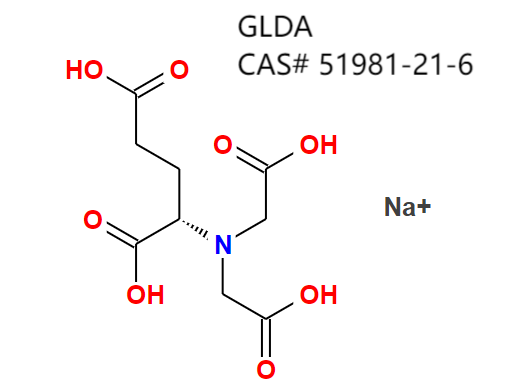CAS No.: 51981-21-6
EC No.: 257-573-7
Chemical formula: C9H9NNa4O8 ;
INCI name: Tetrasodium glutamate diacetate;
Chemical Name:
Glutamic acid N,N-diacetic acid tetrasodium salt;
L-Glutamic acid, N,N-bis(carboxymethyl)-, sodium salt (1:4);
Tetrasodium N,N-bis(carboxylatomethyl)-L-glutamate;
Other Green Chelating Agents:
GLDA é um agente quelante ecologicamente correto. Os agentes quelantes também são conhecidos como agentes sequestrantes, agentes complexantes, como DTPA, EDTA.
O GLDA é biodegradável, livre de fósforo e mais ecológico.
A principal matéria-prima do GLDA é o MSG (Glutamato monossódico), que é de origem natural.
Características:
- Forma complexos solúveis em água com vários íons metálicos em uma ampla faixa de pH, com alta solubilidade em soluções ácidas e alcalinas.
Ao contrário de muitos ácidos aminopolicarboxílicos que são instáveis em ambientes ácidos, o GLDA pode existir de forma estável em ambientes ácidos e quelar íons de ferro.
Em condições alcalinas, o GLDA é amplamente utilizado como um ácido aminopolicarboxílico e pode quelar bem o cálcio e outros íons metálicos. - A resistência a altas temperaturas e o ambiente de alta temperatura a longo prazo também podem manter um desempenho estável.
- O GLDA tem efeito de esterilização e eficiência antisséptica, evitando a descoloração e o odor da formulação ou do líquido do processo. Contém agente quelante de aminoácidos, mais fácil de combinar com a parede celular, destrói as bactérias e melhora o efeito do uso de bactericidas.
Traditonal Chelating Agents:
Aminopolycarboxylates: EDTA, EDTA-Na, DTPA & DTPA-5Na
Polyphosphonates: HEDP, DTPMP, ATMP
The following is the original English text.
A seguir, o texto original em inglês.
GLDA is an environmentally friendly chelating agent (also known as sequestering and complexing agent), biodegradable, phosphorus-free.
GLDA is biodegradable, phosphorus-free, and more environmentally friendly.
The main raw material of GLDA is MSG (monosodium glutamate), which is of natural origin.
GLDA can replace traditional complexing agents such as organophosphorus, EDTA and NTA within a certain range.
Features:
- Form water-soluble complexes with various metal ions in a wide pH range, high solubility in acidic and alkaline solutions.
Unlike many aminopolycarboxylic acids which are unstable in acidic environments, GLDA can exist stably in acidic environments and chelate iron ions.
Under alkaline conditions, GLDA is widely used as an aminopolycarboxylic acid and can well chelate calcium and other metal ions. - High temperature resistance, long-term high temperature environment can also maintain stable performance.
- It has the effect of sterilization and antiseptic efficiency, preventing the formulation or process liquid from discoloration and odor. Contains amino acid chelating agent, easier to combine with the cell wall, destroy the bacteria, improve the effect of the use of bactericides.
Technical Data:
Appearance: colorless to light yellow liquid, aqueous solution;
pH: 11±1 (solution, 25°C);
Density: 1.30~1.50 (solution, 25°C);
Specifications are subject to change without prior notice.
Applications:
GLDA is mainly used as a chelating agent and can be adapted to most traditional chelating agent application scenarios.
Scale inhibitors and descalers, industrial cleaning agents, household detergents, hydrogen peroxide bleach stabilizers (e.g. pulp and paper making, textile bleaching), textiles auxiliaries (metal ion shielding/sequestering agent), metal surface treatment, gas sweetening/desulfurization (iron ion carriers), oilfield chemicals, car cleaning agents, agriculture, etc.
Traditonal Chelating Agents:
Aminopolycarboxylates: EDTA, EDTA-Na, DTPA & DTPA-5Na
Polyphosphonates: HEDP, DTPMP, ATMP
Package and storage:
25kg or 30kg per plastic drum;
125kg, or 250kg per plastic drum;
1250kg per IBC.
Store in a cool and ventilated place indoors, moisture-proof, storage period of 12 months.
Related Water Treatment Products:
| Abbreviation | Product Name | CAS No. | Category |
|---|---|---|---|
| DBNPA | Acetamide,2,2-dibromo-2-cyano- | 10222-01-2 | Biocidal active substances |
| BNP (Bronopol) | 2-Bromo-2-nitro-1,3-propanediol | 52-51-7 | Biocidal active substances |
| PHMB | Poly(hexamethylenebiguanide) hydrochloride | 32289-58-0; 27083-27-8; | Biocidal active substances |
| PHMG | Polyhexamethyleneguanidine hydrochloride; PHMG chloride | 57028-96-3 | Biocidal active substances |
| CMIT/MIT | 3(2H)-Isothiazolone,5-chloro-2-methyl-,mixt. with 2-methyl-3(2H)-isothiazolone | 55965-84-9 | Biocidal active substances |
| Chelating Agents | Complexing Agents, Sequestering Agents: EDTA, DTPA, HEDP, DTPMP, GLDA, MGDA, IDS, ASDA, etc. | Cleaning Agents, Softener, Scale Inhibitor, etc. | |
| HPMA | Hydrolyzed polymaleic anhydride | 26099-09-2 | Polymer, dispersant, scale inhibitor |
| PESA | 2,3-Oxiranedicarboxylic acid, disodium salt, homopolymer | 109578-44-1 | Polymer, dispersant, anti-scaling |
| Sodium Polyaspartate | Polyaspartic Acid Sodium Salt; PASP-Na; | 34345-47-6; 94525-01-6; 181828-06-8 | Polymer, dispersant, scale inhibitor |




